The Uromastyx is a genus of lizard that includes 13 different species.
Originating from Africa, India, and the Middle East, this reptile thrives in the harsh conditions of the Sahara Desert.
The Uromastyx, also known as the Spiny Tailed Lizard, makes an excellent choice for beginners because of their unique appearance, intelligent nature, and temperament in captivity. Although quite active, they are known to be docile, having excellent temperaments.
Costing between $100 and $200, they are medium-sized lizards, with most species reaching an adult size of approximately 25cm to 90cm in length.
There is a common misconception that all lizards thrive on a diet of insects. This species is almost entirely herbivorous, thriving on a diet of leafy greens and vegetables.
If you want to learn how to care for this lizard and their husbandry needs then keep reading this care sheet.
What Is A Uromastyx?
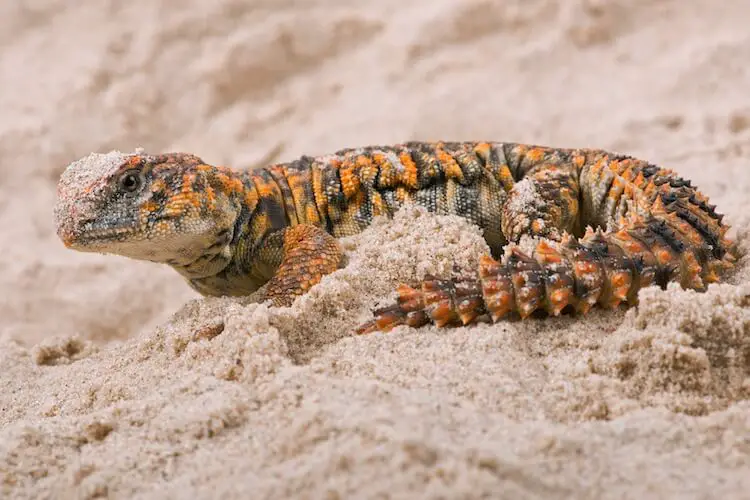
The Uromastyx is a Spiny Tailed Lizard which is found in the rocky and desert climates of Asia and Africa. They enjoy basking in the sun during the day and retreating to the safety of rock formations during the night.
Their unique tail, medium size, and species’ diversity are why owners love adding this reptile to their collection.
Although there are 13 species worldwide, six species are available as pets in the United State, the Uromastyx:
- Ornatus (Ornate Spiny Tailed Lizard)
- Aegypticus (Egyptian Spiny Tailed Lizard)
- Acanthinurus (Bell’s Dabb Lizard)
- Ocellatus (Ocellated Dabb Lizard)
- Hardwicki (Hardwicke’s Spiny Tailed Lizard)
- Benti (Bent’s Spiny Tailed Lizard)
These lizards are known for their iconic spiny tail consisting of 10 to 30 scales which they use as weapons to fight off predators in the wild.
Interestingly in the wild, these lizards can survive without direct bodies of water, acquiring their hydration solely from cactuses and other desert plants.
| Quick Summary | |
|---|---|
| Common Name | Spiny Tailed Lizard |
| Scientific Name | Uromastyx spp (many subspecies) |
| Price | <$200 |
| Size | 10 to 36 inches Snout to vent length of 5cm at birth |
| Lifespan | 15 years |
| Diet | Mostly leafy greens and vegetables |
| Tank Size | 40 gallon |
| Humidity & Temperature | Daytime temperature: 85 degrees Night-time temperature: 75 degrees Basking area: 100-115 degrees Humidity: 35% |
| Popular Alternatives | Bearded Dragons |
Uromastyx Care Sheet
As a desert species, they enjoy very hot temperatures during the day and mild temperatures at night.
Like many other reptiles, they spend a great deal of time basking in direct heat. Uromastyx are cold blooded organisms, controlling their body temperature through their environment.
In addition to hot temperatures, the Uromastyx needs a relatively low humidity to mimic desert-like conditions that they are evolved for in the wild. Finally, UVB light supplementation is essential for their body’s ability to process calcium.
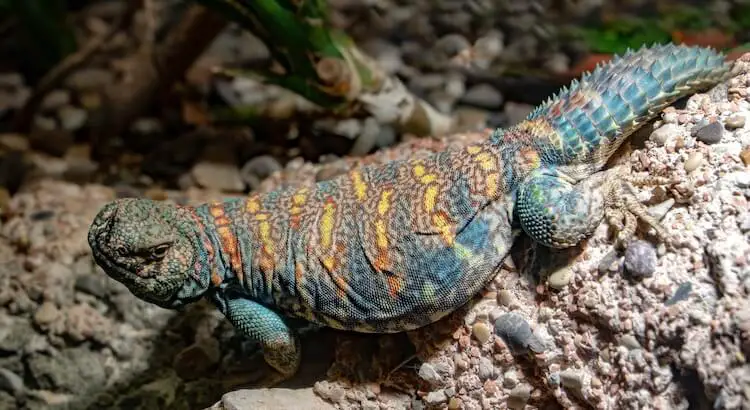
Housing and Set Up
Glass terrariums are preferred for this species due to their ease to clean and sanitize. However a plexiglass enclosure will retain heat more efficiently which may be a good choice for this heat-loving animal:
- Start with a 20-gallon terrarium for a juvenile.
- Once they reach their full-size (3 to 5 years), a 100-gallon terrarium is required.
Plenty of hiding spots are necessary for Spiny Tailed Lizards. You should place rock formations and branches in their tank to replicate their wild habitat. They naturally like to burrow when intimidated, so ensuring they have a place to hide is critical to their health.
Lighting
For a Uromastyx enclosure, UVB lighting is required for between 10 to 12 hours per day. UVB is necessary to process calcium, without it they can develop a wide range of health problems including metabolic bone disease.
This lighting can be added directly on top of a metal mesh tank covering. Alternatively, a UVB lightbulb can be installed into a hood containing a light bulb socket.
Heating
Ceramic heaters, under-tank heaters, or direct heat bulbs are all appropriate as long as ideal cage temperatures are met. In the daytime tank temperature should be kept at a gradient between 80-100°F. Having multiple digital temperatures is required to ensure appropriate temperatures are maintained within their enclosure.
Heating devices should be turned off at night to allow the enclosure to reach a night-time temperature of approximately 75°F.
A specified rock for basking should be included in their housing too. The temperature of that rock should reach temperatures between 110-130°F. This is key to their health because they are cold blooded.
Your Uromastyx should not be misted directly, but greens and vegetation can be misted to ensure the humidity stays low and does not exceed 35%.
Substrate
Many owners report that sand is the ideal substrate for this species of lizard. It allows for their normal burying behaviors, especially when they are intimidated. If you decide not to use sand, make sure to include a small box of sand in their enclosure for burrowing.
For juveniles, it’s recommended that you use paper towels or shredded newspaper (instead of sand) to prevent digestive issues.
Tank Cleaning & Misting
Substrate should be changed weekly. At least once a month, everything should be removed from the terrarium and scrubbed thoroughly with hot water and nontoxic/unscented soap.
Commercial terrarium cleaners can also be used as long as everything is rinsed thoroughly afterwards.
| Tank Tips | |
|---|---|
| Tank Type | 40-gallon |
| Lighting | UVB bulb |
| Best Substrate | Shredded aspen bedding |
Uromastyx Diet
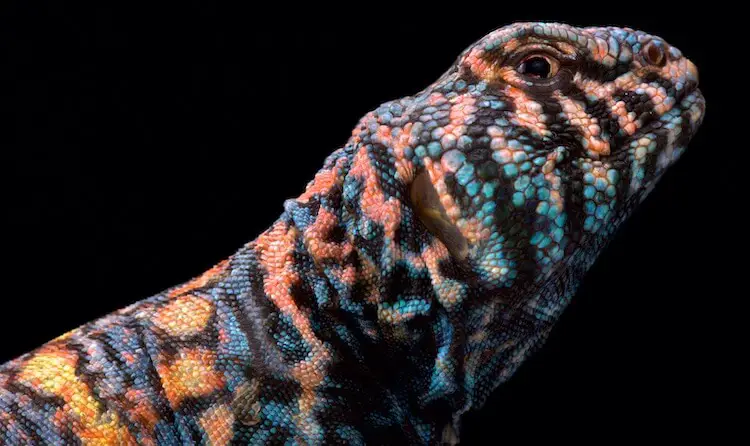
In the wild, this lizard mainly consumes tough desert plants, including grasses, flowers, and cacti. In captivity, these desert plants and flowers can be replaced with a diet of mostly leafy greens supplemented with vegetables.
Seeds also make up a large component of their diet in the wild and are crucial for their protein requirements since Uromastyx are primarily herbivores.
Unlike lots of reptiles, they generally eat every day. Supplying fresh feed daily is a must. Ideally:
- Leafy greens should be fed 7 days a week
- Seeds 6 days a week
- Vegetables 4 days a week
- Calcium supplements 3 days a week
Good vegetables to feed include butternut squash, prickly pear leaves, hibiscus flowers, bell peppers, and okra. If owners choose to occasionally give fruits they can use berries, figs, or kiwis.
Owners should keep in mind that insects and fruits are really only added for enrichment purposes, not nutritional purposes.
It is a misconception that growing juveniles should be fed a higher-protein diet full of insects. These diets can lead to a wide variety of health detriments. If insects are included in the diet, they should make up no more than 5%. Good insects to occasionally feed are crickets, roaches, hookworms, and soldier fly larva.
A small water dish can be provided to your Uromastyx. However, as long as owners are providing adequate nutrition daily, their water requirements will be met and they will most likely avoid drinking.
| Diet Summary | |
|---|---|
| Fruits | 0% of diet |
| Leafy Greens | 70% of diet |
| Vegetables | 10% of diet |
| Seeds | 20% of diet |
| Insects | 0% of diet |
| Supplements Required | Calcium carbonate |
Keeping Them Healthy
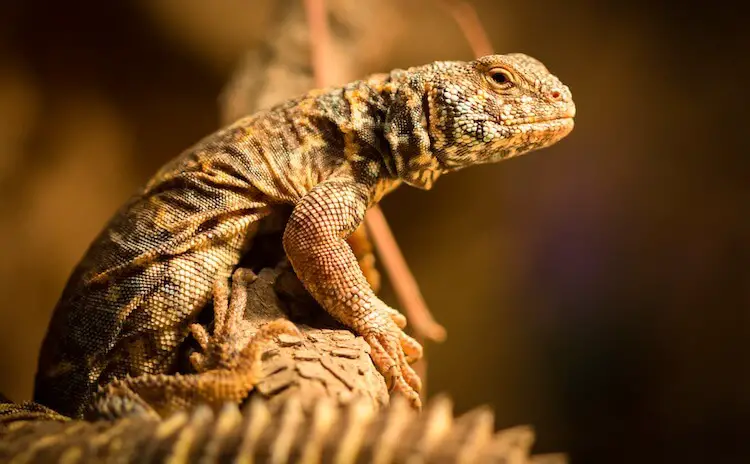
In the wild, Uromastyx typically live for about 30 years. However, in captivity, most live for between 15 and 20 years.
Poor husbandry can contribute to many health issues. Common health issues include: metabolic bone disease (from an absence of UVB light), impaction (from improper substrate or diet), dehydration (from incorrect diet), tail rot, and dermatological issues.
Your Uromastyx should defecate 1 to 4 times per day, and the feces should be solid and well formed.
Feces should be removed from tanks daily. If your lizard is defecating less often, or the feces are watery and not well formed, then a dietary issue may be present.
Bathing is not recommended for this lizard as they are desert species and it is not a natural behavior of theirs. In addition, there is great potential for them to aspirate water and develop pneumonia from baths.
Like with other lizard species, the Uromastyx shed their skin in patches. Juveniles may shed their skin monthly with adults shedding their skin only once every year or two.
| Signs They Are Healthy | Sickness Symptoms |
|---|---|
| Nose and vent clear | Weight loss |
| Defecate 1 to 4 times daily | No defecating |
| Active, bright, and alert | Darker colors |
| Smooth and uniform skin | Sunken eyes |
Typical Behavior
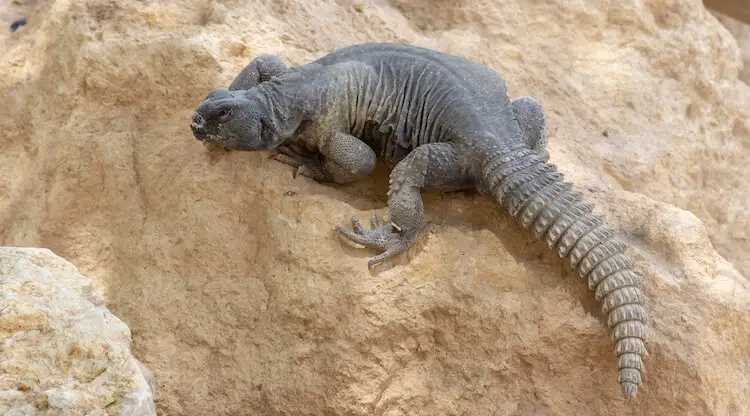
In the wild, the Uromastyx will have a designated burrow.
During the day, they will leave their burrow and bask in the sunlight on rocky structures. During the night, they will retreat to the burrow to avoid predators.
In the winter months, if cooler temperatures come, they have been known to hibernate for 2 to 5 months. In summer months, if resources are scarce, they can implement a hibernation-like behavior to conserve energy until resources become available again.
Uromastyx tend to be aggressive with other members of their species.
In addition, adult males use various bodily glands to mark their territory, use their tail as a weapon, and tend to bite their opponents. They should either be housed individually, or have one male housed with up to three females as long as they are monitored closely.
If females are housed together they will form a hierarchy. In the wild, they live a solitary lifestyle and only travel away from their burrow if food is scarce.
Mating
Males attract females through specific mating behaviors like head swinging and push-ups. Males also tend to chase females during courtship.
Courtship typically consists of a few waves each season, and lasts a few minutes.
It takes 60 to 80 days for Uromastyx eggs to hatch depending on the species and tank specifics, and Uromastyx will have anywhere from 4 to 20 eggs.
Handling
They are typically docile and not aggressive towards humans.
Handling should be slowly integrated. It may take multiple months of handling before a Uromastyx is comfortable being handled.
When handling, any movements should be slow and controlled to ensure not to startle or scare your lizard. They can be held by supporting their underside. All lizards have the capability to bite, but, if handled correctly and frequently, they tend to be docile.
Appearance

Males are typically larger than females and have femoral pores on their thighs. These pores release a waxy secretion. Males also tend to have a broader head than females.
Some species of Uromastyx are sexually dimorphic, and males can easily be distinguished from females due to obvious differences in colorations. The Ornate Spiny Tailed Lizard is a good example. Ornate males have a bright blue, green, or red color while the females tend to be a duller brown.
Size
Adults weigh anywhere from 100 grams to 900. Males tend to be slightly larger than females.
Hatchlings start out at about two to four inches long and ultimately grow to an adult size of 10 to 36 inches (depending on the species of Uromastyx).
It takes approximately three to five years for a Uromastyx to reach their adult-size.
Color
Coloration for this lizard is temperature and species dependent. The Uromastyx have variations of grey colorations in colder temperatures and tan/brown colorations in warmer temperatures:
- The Egyptian Spiny Tailed Lizard and Hardwicke’s Spiny Tailed Lizard are dull in color consisting of mostly greys, tans, and whites.
- The Ornate Spiny Tailed Lizard has brighter more prominent coloring.
Some of the brighter colored species have different morphs.
The white morph of the Ornate Spiny Tailed Lizard is popular because it lacks the typical black pigmentation.
Baby Uromastyx Hatchlings
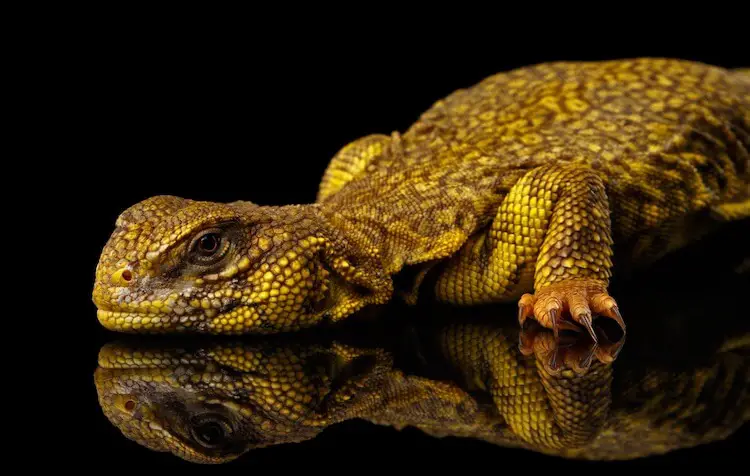
Hatchlings should be raised in their own individual tank with paper towel or shredded newspaper substrate.
They will start eating a day or two after hatching and can be fed the same diet as adults (leafy greens and fewer seeds), just chopped into smaller pieces.
How Much Does A Uromastyx Cost?
You should expect to spend $100 to $200 to buy this lizard and anywhere from $250 to $500 for an appropriate enclosure with all the necessary decorations and lighting equipement.
As they have recently gained in popularity, buying them has become much easier. They can be purchased online from breeders or from many pet shops.
When buying make sure you do a proper inspection of the lizard. Ensure your Uromastyx is bright and alert and has no obvious health abnormalities such as skin lesions or a blocked/crusty vent.
You should also talk with the seller about how the lizard was raised and what it was fed.
Care Guide Summary
| Pros | Cons |
|---|---|
| Easy and relatively cheap to feed, not requiring large amounts of insects. | Require a relatively large aquarium (40 gallons for adults). |
| Have great personalities and are an extremely intelligent species. | Require pretty high temperatures (85°F with a basking spot >100°F). |
| They are resilient and can live in captivity for 15 years. | They can be skittish at first and may take a while to become comfortable with handling. |
With over 13 different species, there are many different colorations of Uromastyx to choose from! Finding the perfect one for your household can definitely be an adventure.
The Uromastyx makes a great beginner lizard and has recently become a popular addition for many herpetologists.
They have specific husbandry needs (high tank temperatures, large tanks, and a leafy plant based diet), but are are suitable for almost any owner as long as careful attention is placed on establishing and maintaining their enclosure.
Bearded dragons are a medium-sized desert lizard that is a good alternative to Uromastyx.
Some of the most intelligent and personable lizards in the world, let us know what you think in the comments below.

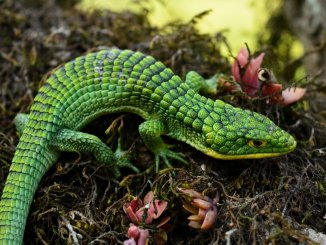
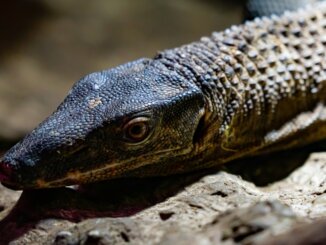
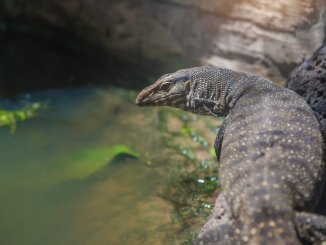

A lot of this information is misleading or incorrect. To start, a minimum tank size of 120 G is required for this species. This allows enough room for this active species to explore and achieve the proper heat gradient (proper heat and UV is often challenging to achieve; 120F-130F surface basking spot with 80-100 F ambient temp gradient across the enclosure + T5 high output 12% or 14% UV tube). Glass enclosures are specifically recommended against as they don’t hold heat well. A front opening enclosure that is glass/plexi in the front is generally the best for this skittish species that doesn’t like to be approached from above. Most are wild caught and loaded with high parasite levels as a result are in a rehab situation when “beginners” get them; many die quickly in this situation. Uromastyx can be handled but don’t generally enjoy it (unlike bearded dragons which do). Seeds/lentils should be no more than 5% of the diet.
Hello , I have orange with black spot Uromastyx , and I seen yesterday one wart in His hand
This seems to be a problem for a vet! He or she help your Uromastyx with creams, general medicines or, in the worst case scenario, surgery. Make sure you clean and sanitize your enclosure on a regular weekly or bi-weekly basis to prevent these issues.